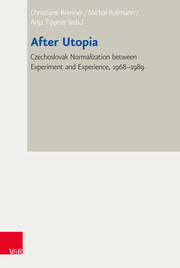Detailansicht
After Utopia
Czechoslovak Normalization between Experiment and Experience, 1968-1989, Bad Wiesseer Tagungen des Collegium Carolinum 41
ISBN/EAN: 9783525336144
Umbreit-Nr.: 1992003
Sprache:
Englisch
Umfang: 406 S., 11 s/w Illustr., 11 Illustr., 11 Fotos
Format in cm: 3.2 x 23.7 x 15.5
Einband:
gebundenes Buch
Erschienen am 14.02.2022
Auflage: 1/2022
- Zusatztext
- The Husák government that came into power after the suppression of the Prague Spring formulated the goal of restoring "normality" in Czechoslovakia. It revoked prior reforms and initiated widespread "cleansing measures" and repression. Most notably, however, it lacked a clear vision for the future. The contributions in this volume show that the 1970s and 1980s were nevertheless not a time of complete stagnation. Efforts at restoration and modernization frequently existed simultaneously and counteractively. The essays discuss this contradictoriness and the often invisible dynamics of the normalization period exemplarily. A further key topic is the normalizations echo in literature, remembrance culture, and historiography.
- Kurztext
- The volume analyzes developments, expectations, and experiences during the so-called normalization following the suppression of the Prague Spring.
- Autorenportrait
- Dr. Christiane Brenner ist Wissenschaftliche Mitarbeiterin am Collegium Carolinum, Forschungsinstitut für die Geschichte Tschechiens und der Slowakei.
- Schlagzeile
- The Husák government that came into power after the suppression of the Prague Spring formulated the goal of restoring "normality" in Czechoslovakia. It revoked prior reforms and initiated widespread "cleansing measures" and repression. Most notably, however, it lacked a clear vision for the future. The contributions in this volume show that the 1970s and 1980s were nevertheless not a time of complete stagnation. Efforts at restoration and modernization frequently existed simultaneously and counteractively. The essays discuss this contradictoriness and the often invisible dynamics of the normalization period exemplarily.
